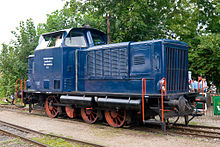MaK rod locomotives

The MaK rod locomotives are a range of diesel locomotives with rod drive that were produced from 1953 to 1966 by the company Maschinenbau Kiel (MaK).
history
After the Second World War , the war damage and the failure to renew the vehicle fleet at all railway companies created a great need for new vehicles, while at the same time the German locomotive industry had gained experience in diesel locomotive construction with the WR 200 B and WR 360 C locomotive types for the Wehrmacht. Like many other locomotive manufacturers, MaK therefore initially offered a further development of the WR 360 C after the war, of which 18 units were delivered to the Deutsche Bundesbahn as the V 36 4 series .
In the following years, the locomotive manufacturers developed standardized diesel locomotive type programs based on this, especially for private and industrial railways, but that of MaK differed in some points from those of other manufacturers. For example, the locomotives were given a central driver's cab and flatter front ends to improve visibility. Four-axle locomotives were also offered, with the two outer axles being connected with a so-called Beugniot lever so that they can be laterally displaced in relation to one another in order to improve cornering.
Type range
The first type of program included the types 240 B , 240 C , 400 C , 600 D and 800 D . The designation of the series includes the engine power in HP and the wheel alignment . The two locomotive types with 240 hp received a six-cylinder engine of the type MS24, for the others six and eight-cylinder engines of the type MS / MA 301 were used. Many of the locomotive's components were identical so that, for example, the superstructures could be produced in large numbers and kept in stock for further orders. The chassis differed, however, there were three different frame lengths: the two small types were 7,700 mm long, the 400 C was 9200 mm long and the two large types were 10,600 mm long.
In 1955, MaK developed the V 65 series from type 600 D for the German Federal Railroad , 15 of which were delivered by 1956. No further construction was carried out in favor of the V 100 series . The V 65 differs from the 600 D in that it has a more powerful engine, a coke oven for preheating or keeping the locomotive warm during breaks, and other details.

From 1957 further developments were the engine type 301 available, so could new locomotive types are available with higher power, these were the 650 D , 850 D , 1000 D and 1200 D . These locomotives were built on frames with a length of 11,360 mm, so they were longer than the previous types, which were soon converted to the longer frame design.
The types 240 B and 240 C received a new driver's cab from 1960, which looked more modern with steeper fronts and windows; the other types continued to have the old driver's cab. From 1961, the last locomotive type was added with the 450 C , when the MS 301 F was another further development of the 301 engine.
In a broader sense, the "hut locomotives " of the types 600 C and 650 C built between 1960 and 1962 can also be counted among the MaK rod locomotives, as these are also based on components from the first MaK type range. The chassis and superstructures of these types are, however, designed significantly differently in order to better adapt them to the intended use.
From 1965 and 1966, MaK switched locomotive production to a new type program in which power was no longer transmitted via jackshafts and coupling rods , but via cardan shafts . By this time, a total of 459 rod locomotives had been delivered to the DB, private and works railways and abroad.
The locomotives were primarily bought by private railway companies from Germany and other European countries who replaced their remaining steam locomotives or older, lower -powered diesel locomotives with the MaK rod locomotives . In the first few years after the introduction of the model range, however, domestic and foreign state railway companies also appeared as buyers, for example 46 type 800 D locomotives were delivered to Sweden to Statens Järnvägar , and a further 42 type 600 D and 800 D units received the Ferrocarriles de Cuba . Larger series were also delivered to Nigeria and Turkey.
In Germany, numerous 240 B found their way to mining companies and steelworks, especially in the Ruhr area, with the larger locomotives the East Hanoverian Railways and the Bentheimer Railways are particularly worth mentioning, each of which had a total of 13 machines of different types in use.
As of 2007, only a few of these machines are still in use, the whereabouts of some are unknown, but numerous have been preserved in museums or as memorials.
See also
List of rolling stock of Maschinenbau Kiel


